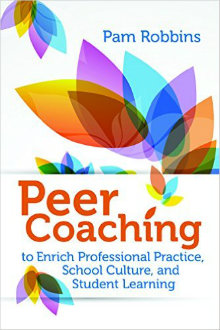A Comprehensive Guide to Peer Coaching
Peer Coaching to Enrich Professional Practice, School Culture, and Student Learning
By Pam Robbins
(ASCD, 2015 – Learn more)
 Reviewed by Holly Foley
Reviewed by Holly Foley
How would you feel if your colleague from down the hall came into your classroom and observed your teaching? Now, keep in mind, this is NOT for evaluative purposes, but merely to help you be reflective about your teaching practice.
The colleague is someone you trust and like. Before the visit, you would have spoken together about your goals. And you get to debrief afterward and commiserate/brainstorm about the good and not-so-good parts of your lesson.
In this kind of “peer coaching” model, you also get to play the role of the observer and have the chance to observe new strategies in other classrooms as well as possibly getting to see your students in a new light. I know it seems scary, but it can be some of the best professional growth you’ll ever experience if you are willing to take the risk. And it will establish relationships that make teamwork much easier and make teaching less isolating.
 Read the new book by Pam Robbins, Peer Coaching to Enrich Professional Practice, School Culture, and Student Learning to find out more!
Read the new book by Pam Robbins, Peer Coaching to Enrich Professional Practice, School Culture, and Student Learning to find out more!
Take it from a new coach . . .
Being recently trained in coaching by my region makes me a natural supporter of the strategy of peer coaching. My background in the philosophies and strategies of this kind of professional learning meant that this book was not brand new information for me. On the other hand, I can say for certain that it is really a comprehensive guide and would be a wonderful faculty book study in preparation for a peer coaching program in your school.
Pam Robbins uses ten chapters and very practical appendices to provide a well thought out road map to addressing all of the issues and challenges surrounding the idea of making teaching less of a solo adventure. She also uses my favorite African proverb, “If you want to go quickly, go alone. If you want to go far, go together.”
What’s in the book
In this book you will learn how to establish the rationale for peer coaching. The idea of collaborative work vs. formal coaching is explored in Chapter 3 as a way to differentiate readiness for the topic. Very specific, intriguing models of collaborative work are discussed: storytelling about teaching practices, video analysis, problem solving to enrich professional practice, study groups, conversations about student work, book talks, data talks, and co-planning lessons.
Each chapter provides a balance of research supported strategies, discussion of theory and practice, anecdotes, a summary, and reflective questions. I feel that the chapters of this book would also make terrific stand-alone articles, but taken together they are truly a principal’s gift in navigating a staff toward this enriching model.
There are several chapters devoted to formal observations. Included are strategies and samples questions for pre-conference, post conference and ideas for methods to collect data during the observation, including a verbal flow chart. The most critical understanding to establish about peer coaching is that it is separate and distinct from teacher evaluation. The point is made several times that it is preferable to have this experience be voluntary.
Examples of valuable nuggets in this new title
In chapter 5 “Creating the Effective Pre-conference,” one can learn a variety of strategies for establishing a trustful relationship and having pointed discussions about the goals of a coaching experience. This chapter is so valuable and offers coaches a meaningful decision-making chart for follow-up questions. I feel like this whole chapter could also be used to very effectively coach language arts teachers in a reading/writing workshop model when trying to get learners to be reflective about how to move themselves forward in almost any learning environment. The skills of paraphrasing and clarifying are universal in teaching.
Not to be ignored is the very important chapter on “Cultivating the Context for Peer Coaching.” This chapter includes many real life examples of successful coaching in schools and frankly considers the barriers to succeeding. There are discussions about Daniel Pink’s work on engagement, autonomy and play as well as key questions by Ray McNulty involving why and how to change. There are also good summaries of Michael Fullan’s work on change. So if you are looking for a review of substantive recent educational research, this book has that for you as well.
The book has great appendices!
Finally, my favorite feature is the appendix section. Here you will find reflections from school leaders, which are summaries addressing all of the important questions brought up throughout the book like “Why” and “How” to implement Peer Coaching. Additionally there is an invaluable set of pre- and post-conferencing questions. And there is also a suggested format for implementation of this idea over a series of professional development days. If you are an administrator or staff development coordinator, these ideas about when and how to address each topic will be valuable to you.
Coaching improves our own teaching
I cannot say enough about how my personal experience being a regional coach has enriched my teaching experience. After being in another classroom, I am rejuvenated with new ideas. The relationships I have built help me feel less isolated and more positive about teaching. The basis exists for fundamental understandings about our students and their widespread skills and abilities. I do believe student achievement is advanced through this strategy and professional growth is surely a byproduct.
I hope you will consider embracing Pam Robbins’ handbook about the topic. Peer Coaching to Enrich Professional Practice, School Culture, and Student Learning has provided research, broad questions and discussions, and practical treats to make any school a successful breeding ground for this exciting and productive idea.
Holly Foley has been an educator for over 25 years in grades K-8 in Bergen County, NJ. She is recently remarried and has two college age children. Holly has been formally trained by Northern Valley Curriculum Center Coaching Academy and coaches teachers in her region. She loves Twitter as an educational resource @Hollyprocida and is looking forward to helping students and staff have another year of joy, growth, and excitement in the classroom. You can follow her blog at School Stuff.

































